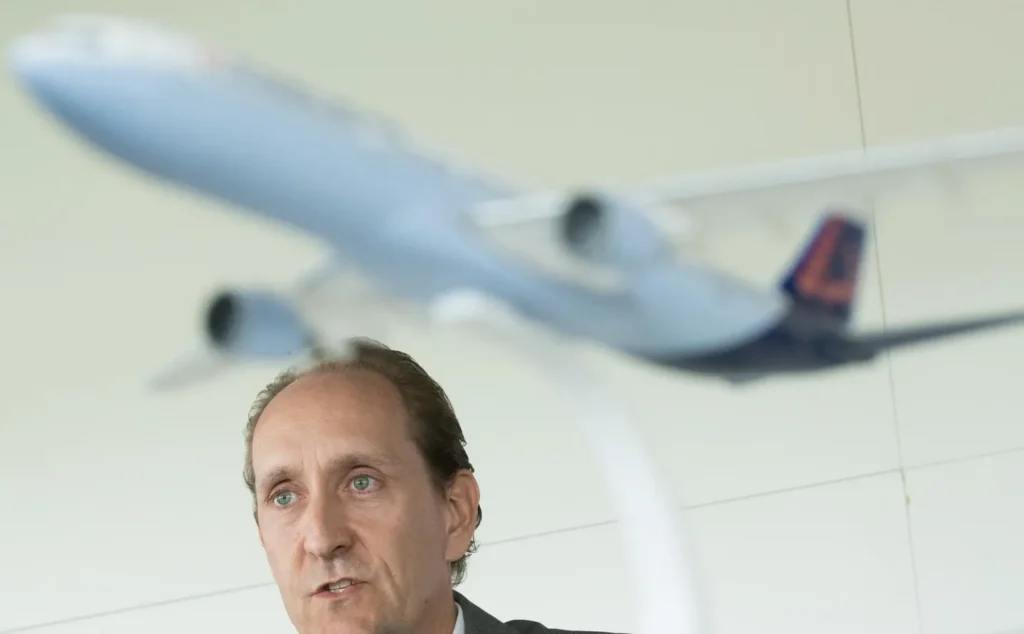Mar 7, 2024,04:45am EST
Climeworks, a startup specializing in direct carbon dioxide capture from the atmosphere, has forged a partnership with Swiss Air Lines to eliminate significant CO2 emissions on behalf of the European airline, marking a groundbreaking agreement in the industry.
The collaboration between the two Zurich-based entities spans seven years, extending until the end of the decade, as revealed by Jan Wurzbacher, Climeworks’ co-founder and co-CEO, in an interview with Forbes. While this marks the first direct carbon capture initiative within the airline sector, specific details regarding the volume of CO2 to be removed and the financial terms of the deal remain undisclosed. Part of the captured carbon may potentially contribute to the production of sustainable aviation fuel rather than being solely stored.
Wurzbacher highlighted the significance of Swiss Air Lines’ decision, stating, “It’s not like a steel mill, but it’s an airline — from a generally heavy emitting industry — that came to the conclusion that (carbon dioxide removal), in particular direct capture, can be something valuable.”
Climeworks, backed by approximately $800 million in funding and valued at $1.9 billion, initiated operations of Orca in Iceland in 2021, marking the world’s first large-scale carbon capture facility. Utilizing large fans, Orca draws in CO2 from the surrounding air, which is then combined with water to create a solid material subsequently stored underground. While currently capable of removing 4,000 tons of CO2 annually, Climeworks is constructing a significantly larger facility named Mammoth near Reykjavik, aimed at capturing 36,000 tons of CO2 per year.

Swiss Air Lines CEO Dieter VranckxAFP VIA GETTY IMAGES
Before the Swiss collaboration, Climeworks unveiled multiyear carbon removal projects with JP Morgan Chase, Microsoft, BCG, Stripe, and insurer Swiss Re.
Direct removal of CO2 is rapidly emerging in the cleantech sector, positioned as a vital complement to initiatives aimed at transitioning transportation, manufacturing, and power industries away from fossil fuels. However, to mitigate the impacts of climate change, thousands of gigatons of CO2 must be eliminated annually.
In contrast to carbon offsets, which airlines and other companies have traditionally purchased, linked to activities like tree planting or wind farm construction, direct carbon removal companies assert their ability to precisely measure the amount of CO2 they capture.
Carbon Reduction Targets “Swiss International Air Lines has set a target to reduce its CO2 by half by 2030, and to be net zero by 2050,” CEO Vranckx told Forbes. Alongside fleet upgrades to cleaner aircraft and a shift to sustainable fuels, the Climeworks project “is another component of reaching those targets.”
One reason Swiss isn’t disclosing a specific target for tons of CO2 that Climeworks will remove on its behalf is that direct air capture, or DAC, remains a nascent technology and may not currently be the most cost-effective option. “It could be in the next couple of years, if DAC really becomes extremely promising and the scalability is much more than we expect, then we will drive more reduction through direct air capture and maybe less through” sustainable aviation fuel, Vranckx said.
Airlines accounted for 12% of global CO2 emissions from the transportation industry in 2022, according to the International Energy Agency. Swiss’s goal of achieving net zero emissions by 2050 is in line with industry trends.
Presently, the cost is estimated to be as high as $1,000 and requires 2000 kilowatt-hours of power for every ton of CO2 removed. Climeworks’ current focus on scaling up total capacity to eliminate CO2 hasn’t prioritized minimizing energy usage or achieving cost efficiency, although both are expected to improve over time, Wurzbacher noted.
“Our strategy will be to invest heavily into further technology improvement, and in particular scale-up and cost reduction,” he said. “We need to scale first. We can’t drop prices immediately, to where we anticipate them to be when we have scaled. So that is rather a challenge.”
As more energy companies and rival startups venture into the direct carbon removal market, Climeworks will face increased competition. Equatic, a Los Angeles-based company spun out of UCLA, is pursuing commercialization of ocean-based CO2 removal, a process it believes can be significantly cheaper and more energy efficient, costing as little as $100 per ton. However, this technology is still in a relatively early stage of development.
“I don’t think that there will be one technology solely solving this problem,” Wurzbacher said. “And 20 years from now there will be several.”

